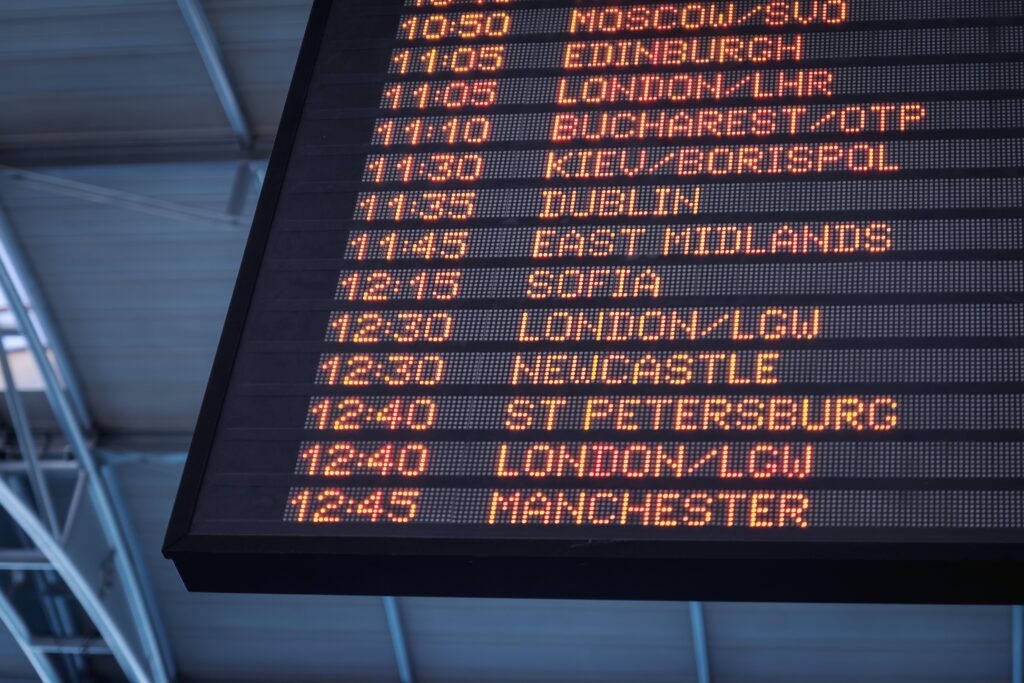Greece Transportation Guide
Greece Transportation Guide: Efficient transport in Greece: Navigate islands by ferries, explore mainland with buses, and experience local charm with taxis and trains.


Greece Transportation Guide – International Airports
Greece is served by several international airports that cater to both domestic and international flights. Some of the major international airports in Greece include:
Athens International Airport “Eleftherios Venizelos” (ATH): Located in Athens, the capital city of Greece, this is the busiest and largest airport in the country. It handles numerous international flights from various destinations worldwide.
Thessaloniki International Airport “Makedonia” (SKG): Situated in Thessaloniki, the second-largest city in Greece, this airport is a significant gateway to the northern regions of the country.
Heraklion International Airport “Nikos Kazantzakis” (HER): Located in Heraklion on the island of Crete, this airport serves as a crucial entry point for travelers heading to Crete and nearby islands.
Rhodes International Airport “Diagoras” (RHO): Situated on the island of Rhodes, this airport receives a large number of international flights, especially during the summer tourist season.
Chania International Airport “Ioannis Daskalogiannis” (CHQ): Located in Chania on the island of Crete, this airport serves as an alternative entry point to Crete, particularly for travelers visiting the western part of the island.
Corfu International Airport “Ioannis Kapodistrias” (CFU): Situated on the island of Corfu, this airport welcomes many tourists, especially during the summer months.
Santorini (Thira) International Airport (JTR): Located on the island of Santorini, this airport serves as a crucial transportation hub for tourists visiting this popular Greek island.
Mykonos International Airport “Eleftherios Venizelos” (JMK): Situated on the island of Mykonos, this airport receives many domestic and international flights, particularly during the summer season.
Zakynthos International Airport “Dionysios Solomos” (ZTH): Located on the island of Zakynthos (Zante), this airport connects the island with several destinations in Greece and abroad.
Kos International Airport “Hippocrates” (KGS): Situated on the island of Kos, this airport is an important gateway for travelers visiting the Dodecanese islands.
National Airports
Greece has 15 national airports operated by the Hellenic Civil Aviation Authority (HCAA). These airports serve domestic flights within Greece and are strategically located to provide access to different regions of the country. Please note that there might be updates or changes beyond my last update. Here are the 15 national airports of Greece:
Alexandroupolis International Airport “Dimokritos” (AXD): Located in Alexandroupolis, in the region of Thrace in northeastern Greece.
Chios Island National Airport “Omiros” (JKH): Situated on the island of Chios in the northeastern Aegean Sea.
Ikaria Island National Airport “Ikaros” (JIK): Located on the island of Ikaria in the northeastern Aegean Sea.
Ioannina National Airport “King Pyrrhus” (IOA): Serving the city of Ioannina in northwestern Greece.
Kalamata International Airport “Captain Vassilis Constantakopoulos” (KLX): Located in Kalamata, in the Peloponnese region.
Karpathos Island National Airport “Aristarchos of Samos” (AOK): Situated on the island of Karpathos in the southeastern Aegean Sea.
Kavala International Airport “Alexander the Great” (KVA): Serving the city of Kavala in northern Greece.
Kefalonia Island National Airport “Anna Pollatou” (EFL): Located on the island of Kefalonia in the Ionian Sea.
Kos Island International Airport “Hippocrates” (KGS): Serving the island of Kos in the southeastern Aegean Sea.
Limnos Island National Airport “Hephaestus” (LXS): Located on the island of Limnos in the northeastern Aegean Sea.
Mytilene International Airport “Odysseas Elytis” (MJT): Serving the island of Lesbos in the northeastern Aegean Sea.
Naxos Island National Airport (JNX): Located on the island of Naxos in the Cyclades.
Paros Island National Airport (PAS): Serving the island of Paros in the Cyclades.
Samos Island National Airport “Aristarchos of Samos” (SMI): Located on the island of Samos in the eastern Aegean Sea.
Skiathos Island National Airport “Alexandros Papadiamantis” (JSI): Serving the island of Skiathos in the Sporades.
Greece Transportation Guide – Trains
Greece has a limited railway network compared to other forms of transportation like buses and ferries. The Greek railway system is managed by the Hellenic Railways Organization (OSE), and it primarily connects major cities on the mainland and some parts of the Peloponnese region. The rail network also includes international connections to neighboring countries.
Here are some key points about the trains in Greece:
Main Railway Lines: The main railway lines in Greece connect Athens (the capital) to Thessaloniki (the second-largest city), Patras, Larissa, and other significant cities. There are also train services that link Athens to the northern borders with North Macedonia and the southern borders with Turkey.
Intercity Trains: Intercity trains operate between major cities, offering a relatively comfortable and scenic way to travel through the mainland. However, the speed and frequency of trains may be limited compared to other modes of transport.
Suburban Trains: The Athens Suburban Railway (Proastiakos) is an essential commuter service that connects Athens to its suburbs, including the Athens International Airport. It’s a convenient way to travel between Athens and nearby areas.
Train Types: The trains in Greece generally fall into three categories: regular trains (InterCity and Regional), Proastiakos (suburban trains), and International trains that connect to neighboring countries.
Ticketing: Tickets for Greek trains can be purchased at train stations, online, or through authorized agents. It’s advisable to book tickets in advance, especially during peak travel seasons.
Scenic Routes: Some train routes in Greece offer beautiful views of the countryside and are popular among travelers seeking a more leisurely journey.
Train Comfort and Amenities: While the Greek train system is generally safe and reliable, the train services may not be as modern or luxurious as those found in some other European countries.


Greece Transportation Guide – Buses
Buses are a popular and widely used mode of transportation in Greece, providing extensive coverage throughout the mainland and connecting various cities, towns, and villages. The Greek bus network is operated by multiple companies, both public and private, and it offers a convenient and affordable way to travel within the country. Here are some key points about the buses of Greece:
KTEL: The primary bus operators in Greece are the KTEL companies, which are regional bus companies. Each region typically has its own KTEL company responsible for bus services within that specific area. These companies offer both long-distance and short-distance routes, making it possible to reach even remote locations.
Interregional Connections: KTEL buses connect major cities, towns, and tourist destinations across the mainland and some of the larger islands. They are an essential means of transport for both locals and tourists.
Frequent Services: Buses in Greece operate frequently, especially on popular routes and major corridors. During the summer months, there are often additional services to accommodate the increased number of tourists.
Bus Terminals: Larger cities and towns usually have central bus terminals where buses depart and arrive. In some cases, smaller villages may have designated pick-up and drop-off points.
Tickets: Bus tickets can be purchased directly at bus stations, from the driver before boarding, or sometimes online. It’s recommended to buy tickets in advance, especially during peak travel seasons.
Island Buses: On the Greek islands, buses are a common mode of transport for both locals and tourists. They offer convenient connections between the main towns and tourist attractions.
Express Buses: In addition to regular KTEL buses, there are express services on some routes, which are faster and have fewer stops, making them ideal for long-distance travel.
Connection with Ferries: Bus services are often coordinated with ferry schedules, allowing travelers to continue their journey to islands seamlessly.
Rural Areas: Buses are especially important for accessing rural and mountainous areas that may not have a railway connection.


We recommend
Greece travel tips
Our guide offers essential Greece travel tips and insights for an unforgettable journey. Plan your trip with us!
Greece Transportation Guide – SIM Cards
Greece Travel SIM Guide:
Providers: Choose from major providers like Cosmote, Vodafone, and Wind for reliable coverage across Greece.
Purchase Options: Buy SIM cards at airports, kiosks, or provider stores. Ensure your phone is unlocked for compatibility.
Data Plans: Select a plan based on data needs. Many providers offer tourist-specific packages with data, calls, and SMS.
Activation: Activate the SIM card by following provider instructions. Registration may be required, so have identification handy.
Coverage: Confirm coverage in your travel destinations, especially if exploring remote areas or islands.
Top-Up: Recharge credit easily at kiosks, supermarkets, or through provider apps to extend services as needed.
Roaming: Check roaming policies if planning to travel beyond Greece. Some plans may include EU roaming benefits.
Emergency Services: Save local emergency numbers and contact your provider’s helpline for assistance if needed.
SIM Return: Keep your SIM card if you plan to revisit Greece, or return it responsibly to avoid environmental impact.
Dual SIM Phones: If your phone supports dual SIMs, consider using a local SIM alongside your home SIM for convenience.
Validity Period: Be aware of the SIM card’s validity period. Some may expire if not used within a specified time frame.
Enjoy Connectivity: Stay connected with ease, share your experiences online, and use navigation apps to make the most of your Greek adventure.
Currency Converter
Currency Converter EUR/USD: Sun, 8 Jun.
Unit Converter
Greece Transportation Guide – Maps
What map do you need?
Choose your destination
More information about this country









